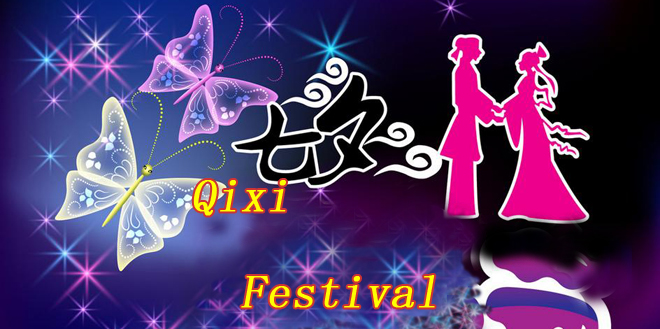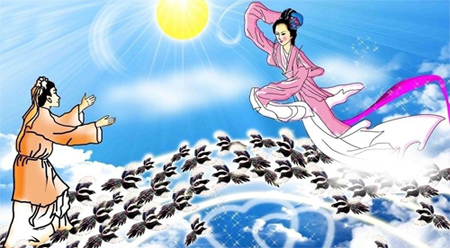| Qixi Festival, also known as the Qiqiao Festival, is a Chinese festival that celebrates the annual meeting of the cowherd and weaver girl in Chinese mythology. It falls on the seventh day of the 7th lunar month. It is sometimes called the Double Seventh Festival, the Chinese Valentine's Day, or the Magpie Festival. This is an important festival, especially for young girls. The festival originated from the romantic legend of two lovers, Zhinü and Niulang, who were the weaver maid and the cowherd. The tale of The Weaver Girl and the Cowherd has been celebrated in the Qixi Festival since the Han Dynasty. The earliest-known reference to this famous myth dates back to over 2600 years ago, which was told in a poem from the Classic of Poetry. The festival inspired Tanabata in Japan and Chilseok in Korea. |
| Mythology The general tale is about a love story between Zhinu and Niulang. Their love was not allowed, thus they were banished to opposite sides of the Silver River. Once a year, on the 7th day of the 7th lunar month, a flock of magpies would form a bridge to reunited the lovers for one day. There are many variations of the story. A variation… view more… | |
| Variations It was said that the Goddess of Heaven, out of pity, decided to let them unite once on the seventh day of the seventh lunar month as she was touched by their love for each other. In some versions it is the Emperor of Heaven, the cowherd's father, or the cowherd's mother who has the role of separating the lovers for them to focus on their work instead of romance. The star Deneb is a fairy who acts as a chaperone when the lovers meet on the magpie bridge. Rather than once a year, there is a version where the lovers were permitted to reunite once a month. There is a belief that sometime during the night of Qixi, the two stars Altair and Vega will actually unite on the same side of the Milky Way. Similar stories are told throughout Asia: in Japan, Korea, Thailand, Laos and Indonesia. In South-east Asia the stories were known as Sudhana Jataka, believed to be one of the stories of the past lives of the Buddha, or the jataka. |
| Present For You In Qixi Festival | ||
| | | |
| Traditions Young girls partake in worshiping the celestials during rituals. They go to the local temple to pray to Zhinü for wisdom. Paper items are usually burned as offerings. Girls may also recite traditional prayers for dexterity in needlework, which symbolize the traditional talents of a good spouse. Divination could take place to determine possible dexterity in needlework. They make wishes for marrying someone who would be a good and loving husband. During the festival, girls make a display of their domestic skills. Traditionally, there would be contests amongst young girls who attempted to be the best in treading needles under low-light conditions like the glow of ember or a half moon. Today, girls sometimes gather toiletries in honor of the seven maidens… view more… |
Date
The seventh day of the seventh lunar month falls on:
| 13 Aug | 2013 |
| 2 Aug | 2014 |
| 20 Aug | 2015 |
| 9 Aug | 2016 |
| 28 Aug | 2017 |
| 17 Aug | 2018 |
| 7 Aug | 2019 |
| 25 Aug | 2020 |
|
In popular culture Barry Hughart's fantasy novel, Bridge of Birds, is loosely based upon this story, though the two figures are switched. The girl is forced to remain on earth, while her male paramour is in the heavens. She is a peasant girl, and he shepherds the stars. In the 2010 remake of The Karate Kid, the protagonist attends this festival with his female companion and sees the story reenacted in a shadow play. American post-hardcore band La Dispute's song "Four" is written about an alternative version of this story, with a Great King taking the role of separating the lovers, due to her neglecting her duties at the loom. In this version the lovers are a princess and a shepherd, and it replaces all the mythology in the original story. La Dispute's first LP has a recurring theme of this story, including the album title: Somewhere At the Bottom of the River Between Vega and Altair. In Kamen Rider Den-O, the series' second rider, Kamen Rider Zeronos, was based heavily on this legend. His Altair form had the motif of a bull, his Vega form uses a spool of thread for the visor. The sole link between the forms is an imagin called Deneb, linking to the bridge that can reunite the lovers. |










